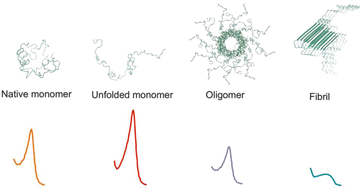Changes in interfacial properties of α-synuclein preceding its aggregation
Abstract
Parkinson's disease (PD) is associated with the formation and deposition of amyloid

* Corresponding authors
a
Institute of Biophysics, Academy of Sciences of the Czech Republic v.v.i., Kralovopolska 135, 612 65 Brno, Czech Republic
E-mail:
palecek@ibp.cz
Fax: +420 5 415 17 249
Tel: +420 5 492 46 241
b Department of Molecular Biology, Max Planck Institute for Biophysical Chemistry, Am Fassberg 11, Göttingen, Germany
Parkinson's disease (PD) is associated with the formation and deposition of amyloid

 Please wait while we load your content...
Something went wrong. Try again?
Please wait while we load your content...
Something went wrong. Try again?
E. Paleček, V. Ostatná, M. Masařík, C. W. Bertoncini and T. M. Jovin, Analyst, 2008, 133, 76 DOI: 10.1039/B712812F
To request permission to reproduce material from this article, please go to the Copyright Clearance Center request page.
If you are an author contributing to an RSC publication, you do not need to request permission provided correct acknowledgement is given.
If you are the author of this article, you do not need to request permission to reproduce figures and diagrams provided correct acknowledgement is given. If you want to reproduce the whole article in a third-party publication (excluding your thesis/dissertation for which permission is not required) please go to the Copyright Clearance Center request page.
Read more about how to correctly acknowledge RSC content.
 Fetching data from CrossRef.
Fetching data from CrossRef.
This may take some time to load.
Loading related content
